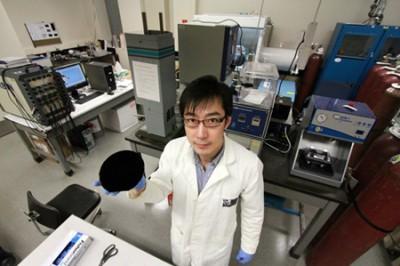 Xinwei Cui holds one of the nano-engineered carbon components of the new
Xinwei Cui holds one of the nano-engineered carbon components of the new battery technology. (Credit: David Dodge / University of AlLberta)
Scientists at the University of Alberta have used a process called induced fluorination to create faster-charging, longer-lasting batteries.
“What we’ve done is develop a new electrochemistry technology that can provide high energy density and high power density for the next generation,” said lead researcher Xinwei Cui, who completed his PhD in materials engineering at the University of Alberta in 2010 and is now chief technology officer at AdvEn Solutions, a technology development company that is working on the battery so it can be commercially manufactured for use in electronic devices.
SEE ALSO: New Material Makes Li-Ion Batteries Last 3 Times Longer
The research team developed the new technology for energy storage using a process called induced fluorination.
“We tried lots of different materials. Normally carbon is used as the anode in lithium-ion batteries, but we used carbon as the cathode, and this is used to build a battery with induced fluorination,” Cui explained.
The advantages of using carbon are that it is cost-effective and safe to use, and the energy output is five to eight times higher than lithium-ion batteries currently on the market. The new battery also performs better than two other future technologies: lithium-sulfur batteries, currently in the prototype stage, and lithium-air batteries, now under development. For example, the induced-fluorination technology could be used to produce cellphone batteries that would charge faster and last longer.
“Nobody knew that carbon could be used as a cathode with such a high performance. That is what’s unique with our technology and what is detailed in our paper,” Cui said.
The team published their findings in the journal Nature Scientific Reports (see footnote). The paper was written by Cui; Jian Chen, a researcher in the National Institute for Nanotechnology; Tianfei Wang, a Ph. D. candidate in materials engineering; and Weixing Chen, professor of chemical and materials engineering at the University of Alberta.
“It wasn’t a quick process. Once we found carbon is different, we persisted for three years until we got results,” Cui said.
AdvEn Solutions hopes to have a prototype by the end of 2014 and aims to develop three versions of the battery to serve different goals. One battery would have a high power output and a long life cycle, the second would have high energy for quick charging, and the third a super-high energy storage.
“We have a long way to go, but we’re on the right track. It’s exciting work and we want everyone to know about it and that it’s very young but promising,” said Cui.
Cui X, Chen J, Wang T, & Chen W (2014). Rechargeable Batteries with High Energy Storage Activated by In-situ Induced Fluorination of Carbon Nanotube Cathode. Scientific reports, 4 PMID: 24931036
